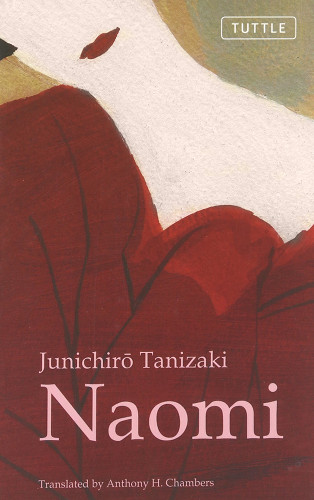Excerpt from the novel Naomi 
 by Junichirō Tanizaki
by Junichirō Tanizaki 


I often used phrases like “mix with Westerners” and “like a Westerner.” Clearly this pleased her. “What do you think?” she’d say, trying out different expressions in the mirror. “Don’t you think I look like a Westerner when I do this?” Apparently she studied the actresses’ movements when we went to the movies, because she was very good at imitating them. In an instant she could capture the mood and idiosyncrasies of an actress. Pickford laughs like this, she’d say; Pina Menicheli moves her eyes like this; Geraldine Farrar does her hair up this way. Loosening her hair, she’d push it into this shape and that.
“Very good–better than any actor. Your face looks so Western.”
“Does it? Where does it look Western?”
“Your nose and your teeth.”
“My teeth?” She pulled her lips back and studied the row of teeth in the mirror. They were wonderfully straight and glossy.
“Anyway, you’re different from other Japanese, and ordinary Japanese clothes don’t do anything for you. How would it be if you wore Western clothes? Or Japanese clothes in some new style?”
“What kind of style?”
“Women are going to be more and more active in the future. Those heavy, tight things they wear now won’t do.”
“How about a narrow-sleeved kimono with an informal sash?”
“That’d be fine. Anything’s all right as long as you try for original styles. I wonder if there isn’t some outfit that’s neither Japanese, Chinese, or Western…”
“If there is, will you buy it for me?”
“Of course I will. I’m going to get all sorts of clothes for you, and we’ll switch them around every day. You don’t need expensive stuff. Muslin and common silk will do. The important thing is to have original designs.”
After this conversation, we often went to drapers and department stores together to look for fabric. We must have spent every Sunday at Mitsukoshi and Shirokiya. But it was hard to find patterns we liked, because neither of us was satisfied with the usual women’s things. Run-of-the-mill drapers were of no use to us, so we went to cotton-print dealers, carpet shops, and stores that specialized in Western fabrics. We even went on full-day outings to Yokohama, where we dragged ourselves from shop to shop in Chinatown and to dry goods stores in the foreign settlement, foraging for the right fabrics. We studied the outfits of Westerners we passed on the street and scrutinized every shop window. If there was something unusual, one of us would cry, “Look, how about that?” We’d rush into the shop, have the fabric brought in from the window and see how it looked on Naomi, draping it from her chin and wrapping it around her torso. We had great fun walking around and window-shopping this way, even when we didn’t buy anything.
Nowadays, it’s fashionable for women to make summer kimonos out of organdy, Georgette, and cotton voile, but Naomi and I were probably the first to use these fabrics. For some reason the textures were very becoming to her. We weren’t interested in conventional kimonos. Instead, she made the material into narrow-sleeved kimonos, pajama suits, and robes that looked like nightgowns. Sometimes she’d simply wrap a bolt of cloth around her body and fasten it with brooches. Dressed in one or another of these outfits, she’d parade around the house, stand in front of the mirror, and pose while I took pictures. Wrapped in gauzy, translucent clothing of white, rose, or pale lavender, she was like a beautiful large blossom in a vase. “Try it this way; now this way,” I’d say. Picking her up, laying her down, telling her to be seated or to walk, I gazed at her by the hour.
Under the circumstances, her wardrobe grew enormously in the space of a year. She couldn’t possibly store it all in her room; she hung things or rolled them up in piles everywhere. We could have bought a cabinet, but that would have cut into our clothes budget, and in any case there was no need to treat her clothes that carefully. She had lots of them, but they were all inexpensive and quick to wear out. It was more convenient to spread them around where we could see them and try various combinations whenever we were in the mood. They also served as decoration for the rooms. The atelier was just like a property room at the theater, with clothes strewn everywhere–on the chairs, on the sofa, in corners, even on the stairs and over the theater box rail. Most of them were soiled, because Naomi was in the habit of wearing them right against her skin, and we hardly ever laundered them.
Most of the designs were so outrageous that she could wear only about half of them outside the house. Her favorite, which she often wore when we went out, was a lined, cotton-padded satin kimono with a matching jacket. Both the jacket and the kimono were a solid, reddish brown, as were the thongs on her sandals and the cord on her jacket. Everything else–the neckpiece, the sash fastener, the lining of the underkimono, the sleeve ends, and the trim at the bottom–was pale blue. The narrow sash, too, was made of thinly padded satin; she wound it tightly, high on her chest. For the neckpiece, she bought a ribbon, wanting something that looked like satin. She wore this outfit most often when we went to the theater in the evening. Everyone turned to look as she walked through the lobby of the Yūrakuza or the Imperial Theater in that glistening fabric.
“I wonder who she is?”
“An actress, maybe?”
“A Eurasian?”
Hearing the whispers, we’d move proudly toward them.
If that outfit amazed people, then Naomi could scarcely have gone out in her more fanciful creations, however much she liked to be unconventional. They were no more than containers–a variety of packages into which I’d put her when we were home, and gaze at her. I suppose it was like trying out a beautiful flower in one vase, then another. There’s nothing so surprising about this. While she was my wife, she was also a rare, precious doll and an ornament. She never wore ordinary clothes at home. Her most expensive indoor outfit was a three-piece, black velvet suit that she said was inspired by a costume she’d seen a man wear in an American movie. When she put it on with her hair rolled up under a sports cap, she was as sensuous as a cat. Both summer and winter (when we heated the room with a stove), she often wore nothing but a loose gown or a bathing suit. She had countless pairs of slippers, including embroidered ones from China. She always wore them without socks.
Like this:
Like Loading...
![]()
![]() by Junichirō Tanizaki
by Junichirō Tanizaki ![]()
![]()


